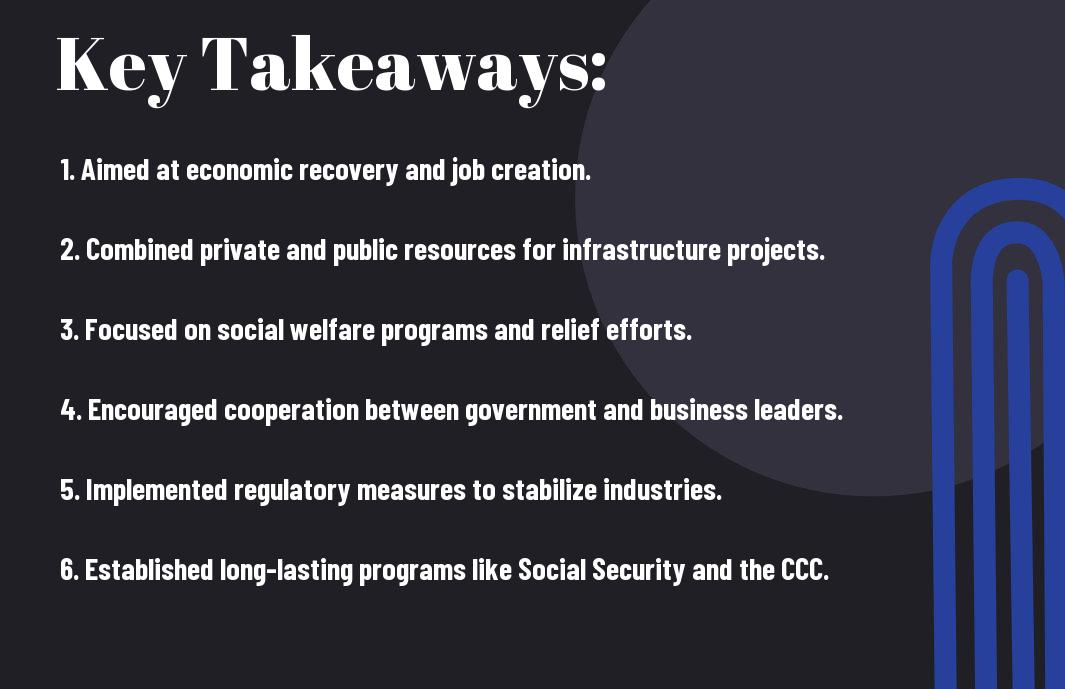Collaboration was a key aspect of the public/private partnerships established under Roosevelt’s New Deal. These partnerships brought together government entities and private businesses to address the challenges of the Great Depression. Through programs like the Civilian Conservation Corps and the Tennessee Valley Authority, these partnerships aimed to stimulate the economy, create jobs, and provide imperative services to the American people. By working hand in hand, the public and private sectors were able to make significant strides in rebuilding the nation’s infrastructure and restoring hope during a time of great uncertainty.
Table of Contents
Key Takeaways:
- Collaborative Efforts: The public/private partnerships under Roosevelt’s New Deal involved collaboration between the government and private businesses to address economic challenges.
- Infrastructure Development: These partnerships focused on infrastructure development projects such as building roads, bridges, and public buildings to create jobs and stimulate the economy.
- Regulation and Oversight: The partnerships included regulations to ensure fair labor practices and oversight to prevent corruption, balancing the interests of both the public and private sectors.

Historical Overview of the New Deal
While the Great Depression ravaged the United States in the 1930s, President Franklin D. Roosevelt introduced the New Deal as a series of programs, public works projects, financial reforms, and regulations to provide relief, recovery, and reform. It aimed to alleviate the economic hardships Americans faced and stimulate the country’s struggling economy.
Key Legislation and Reforms
To address the economic crisis, Roosevelt signed several key pieces of legislation into law. The Emergency Banking Act of 1933 stabilized the banking system and restored consumer confidence. The Securities Act of 1933 and the Securities Exchange Act of 1934 aimed to regulate the stock market and prevent future financial panics. The Social Security Act of 1935 established a system of old-age pensions and unemployment insurance, providing a safety net for Americans.
The Wagner Act of 1935 protected workers’ rights to organize and bargain collectively, while the Fair Labor Standards Act of 1938 established a national minimum wage and maximum workweek. These reforms laid the foundation for a more equitable and secure economic system in the United States.
The Role of Public/Private Partnerships
On top of these legislative efforts, the New Deal fostered public/private partnerships to implement many of its programs. These collaborations between government agencies and private organizations were crucial in executing large-scale infrastructure projects, such as the construction of roads, bridges, and public buildings. Private companies worked hand in hand with the government to create jobs and spur economic growth.
A notable example of a public/private partnership under the New Deal was the Civilian Conservation Corps (CCC), which employed millions of young men in conservation projects across the country. By partnering with the private sector, the government was able to leverage resources and expertise to effectively tackle the challenges of the Great Depression and lay the groundwork for a more prosperous future.
Types of Public/Private Partnerships in the New Deal
After the Great Depression ravaged the United States in the 1930s, President Franklin D. Roosevelt’s New Deal introduced a series of public/private partnerships aimed at revitalizing the economy and providing relief to the American people. These partnerships played a crucial role in stimulating economic growth and creating jobs during one of the nation’s darkest times.
- Infrastructure Development
- Industrial Recovery and Labor Projects
| Infrastructure Development | Industrial Recovery and Labor Projects |
| Public Works Administration (PWA) | Civilian Conservation Corps (CCC) |
| Tennessee Valley Authority (TVA) | Works Progress Administration (WPA) |
| Rural Electrification Administration (REA) | National Recovery Administration (NRA) |
| Federal Housing Administration (FHA) | Public Works Administration (PWA) |
Infrastructure Development
One of the key focuses of the New Deal was on infrastructure development. This involved the creation of agencies such as the Public Works Administration (PWA) and the Tennessee Valley Authority (TVA), which worked on projects like building roads, bridges, dams, and power plants to modernize and improve the nation’s infrastructure. These partnerships between the government and private companies were necessary in providing jobs and boosting economic growth.
On top of that, the Rural Electrification Administration (REA) and the Federal Housing Administration (FHA) were established to provide electricity to rural areas and promote homeownership, respectively. These initiatives not only improved the standard of living for many Americans but also laid the groundwork for future economic prosperity.
Industrial Recovery and Labor Projects
One of the most impactful aspects of the New Deal was its focus on industrial recovery and labor projects. Programs like the Civilian Conservation Corps (CCC) and the Works Progress Administration (WPA) were created to provide employment opportunities for millions of Americans. These projects not only helped rebuild the nation’s infrastructure but also gave people a sense of purpose and dignity during a time of great hardship.
This emphasis on industrial recovery and labor projects helped stimulate demand for goods and services, contributing to the overall economic recovery. By partnering with the private sector to create job opportunities and invest in public works projects, the New Deal set the stage for a more prosperous future for the country.
Impact and Effectiveness of New Deal Partnerships
Economic and Social Outcomes
One of the key economic outcomes of the public/private partnerships created under Roosevelt’s New Deal was the stimulation of the economy during the Great Depression. By partnering with private businesses and organizations, the government was able to create jobs, stimulate consumer demand, and kickstart economic growth. These partnerships facilitated the implementation of programs such as the Works Progress Administration (WPA) and the Civilian Conservation Corps (CCC), which provided employment opportunities for millions of Americans.
Moreover, the New Deal partnerships had significant social outcomes by providing relief to those most affected by the economic downturn. Programs like the Social Security Act and the establishment of the Federal Housing Administration helped to provide a social safety net for vulnerable populations, ensuring a more secure and stable society.
Long-Term Implications for Government Policy
The New Deal partnerships set a precedent for the role of government in addressing economic challenges and promoting social welfare. The collaborative approach between the public and private sectors during the New Deal era demonstrated the effectiveness of government intervention in times of crisis. The success of these partnerships paved the way for future government policies aimed at regulating the economy, providing social services, and ensuring the well-being of the population.
Implications: The legacy of the New Deal partnerships continues to influence government policy to this day, with ongoing debates about the appropriate level of government intervention in the economy and society. The New Deal era marked a shift towards a more active role for the government in addressing social and economic issues, setting the stage for the development of programs and policies aimed at promoting the general welfare of the population.
Analysis and Criticism
Support and Praise for New Deal Partnerships
Many historians and economists have lauded the public/private partnerships established under Roosevelt’s New Deal as innovative and effective solutions to address the challenges of the Great Depression. These partnerships brought together government agencies and private businesses to collaborate on major infrastructure projects, such as the construction of roads, bridges, dams, and public buildings. By pooling resources and expertise, these partnerships were able to stimulate economic growth, create jobs, and improve public infrastructure across the country.
Furthermore, the New Deal partnerships helped restore confidence in the economy and fostered a sense of cooperation between the public and private sectors. This collaborative approach was instrumental in jumpstarting the recovery efforts and laying the foundation for long-term economic stability.
Opposition and Critique of Partnership Approaches
On the other hand, some critics have raised concerns about the implications of public/private partnerships established under the New Deal. They argue that these partnerships may have given too much power to private interests, potentially leading to conflicts of interest and undermining the public good. Critics also point out that some partnerships may have favored certain businesses or industries over others, potentially distorting market competition and perpetuating inequalities.
Despite these criticisms, it is important to recognize that the New Deal partnerships were a product of their time and aimed to address the pressing economic challenges of the Great Depression. While there were shortcomings and criticisms, the overall impact of these partnerships in reviving the economy and building imperative infrastructure cannot be overlooked.

Summing up
Drawing together, the public/private partnerships created under Roosevelt’s New Deal can best be described as innovative collaborations between the government and private sector entities to address the economic challenges of the Great Depression. These partnerships helped stimulate the economy, create jobs, and improve infrastructure, laying the groundwork for America’s recovery. By leveraging the strengths of both sectors, the New Deal initiatives demonstrated the power of collective action in times of crisis and left a lasting impact on the nation’s social and economic landscape.
FAQ
Q: What are public/private partnerships under Roosevelt’s New Deal?
A: Public/private partnerships under Roosevelt’s New Deal were collaborations between the government and private businesses or organizations to address economic challenges during the Great Depression. These partnerships aimed to stimulate the economy, create jobs, and provide relief to those in need.
Q: How did public/private partnerships function under the New Deal programs?
A: Public/private partnerships operated by combining government resources, such as funding and regulations, with the expertise and resources of private entities. This collaboration allowed for the implementation of large-scale projects and initiatives to revitalize the economy and support communities in distress.
Q: What was the significance of public/private partnerships in Roosevelt’s New Deal?
A: Public/private partnerships played a crucial role in the success of Roosevelt’s New Deal programs by leveraging the strengths of both the public and private sectors. These partnerships facilitated the rapid implementation of initiatives such as infrastructure development, social welfare programs, and financial reforms, ultimately leading to economic recovery and stability.
 AIRMAX BLOG Portal Berita Terbaru AIRMAX BLOG
AIRMAX BLOG Portal Berita Terbaru AIRMAX BLOG


